
9 Proven Steps to Write a Better Year-End Fundraising Email Appeal
— Written by Nathan Hill with an intro from Marlin.
Are you ready for the festive fundraising season? With the end of another year rapidly approaching, our Agency Partners at NextAfter have used their digital fundraising expertise to prepare a list of ways you can improve your email appeals. Use them to craft more engaging and effective messaging to your donors. You can find the original article published here.
There are many approaches you can take to writing a year-end fundraising email appeal. But the most effective email appeals do 3 things very well:
- They thoroughly explain the problem at hand
- They articulate the tangible impact a donor can have
- They clearly call donors to give
At the core, these 3 areas of focus help donors understand your value proposition. In other words, they answer this core question: “Why should I give to you, rather than some other organization, or at all?”
If we fail to answer this question effectively, donors will say “No” to giving.
The only way to know how to answer this question well is to a/b test.
We’ve conducted 3000+ online fundraising experiments. And using learnings from those experiments, we’ve identified a simple and easy-to-follow template that you can use as a guide when you write your year-end fundraising email appeals.
Here’s a brief summary of the 9-step email fundraising template:
- Send your year-end fundraising email from a believable human
People give to people, so you should connect with your donors as a real person. Don’t send from the name of your organization. - Add value and mystery to your subject line
Make sure your subject lines convey that there is something valuable in your email. But don’t give everything away! Leave enough mystery to spark curiosity. - Don’t customize your preview text
Custom preview text tells your donor that your email is marketing. Let your preview text naturally pull in the first line of your email. - Say hello and call your donor by name
Your email should be written in a conversational tone – like a message to a friend. Good conversations start with a warm greeting. - Explain the problem at hand
If there’s no problem to be solved, there is no reason to donate. Clearly explain what the problem is that your donor can impact through your organization. - Propose a solution
Help your donor catch the vision for solving the problem at hand. - Articulate the donor’s impact
Help your donor connect their donation to meaningful impact. Be clear, articulate, and don’t be afraid to write a few paragraphs of copy. - Add an incentive to give now
Incentives are not reasons to donate – but they can be reasons to donate now instead of later. Add in a matching opportunity, a clear goal and deadline, or a free gift with a donation. - Provide a clear call-to-action to donate
Your call-to-action needs to clearly ask for a donation. Don’t ask donors to “Stand with us” or “Give hope.” Ask them to donate.
Now let’s dive into the details so you can learn how to apply each step effectively.
1. Send your year-end fundraising email from a believable human
People give to people – not to faceless organizations.
When choosing who to send your year-end fundraising email from, plan to send from a real person at your organization. Not only that, choose someone who your donors can believe has the time to send and respond to emails.
This doesn’t mean you can’t ever send from your president, founder, or chair of the board. This can be powerful from time to time. But err on the side of sending from a more believable sender. This could include your:
- Director of Development/Fundraising
- Donor Communications Specialist(s)
- Volunteer Coordinator(s)
- Marketing and Communications Staff
Since you’re spending the time to learn how to write a better year-end fundraising email, the best sender is probably you.
An Email Sender Experiment
In this email experiment, this organization changed their sender name from the name of the organization to an actual person. As a result, they also revamped the subject line and email coy to reflect the human-nature of the email.
The result? A 330% increase in email opens and a 7x increase in conversions.
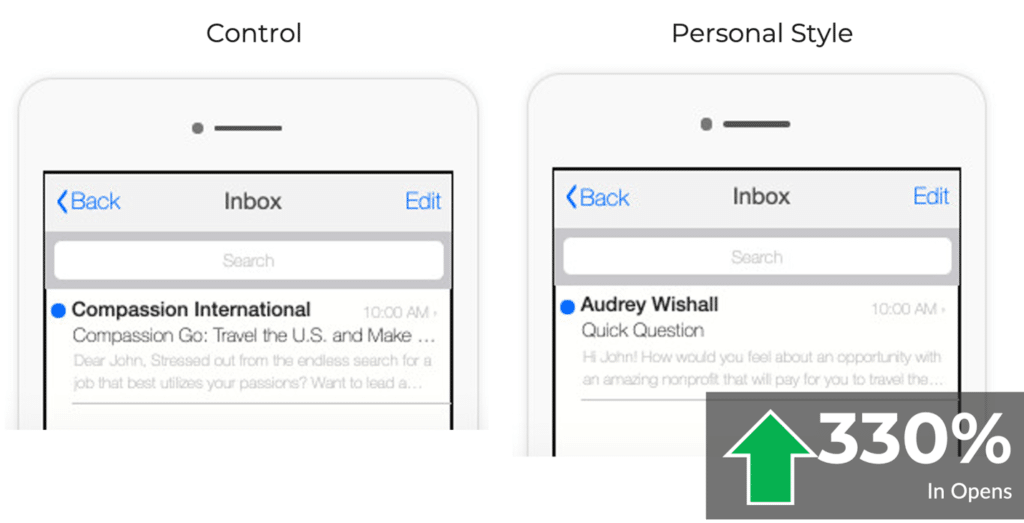
2. Add value and mystery to your subject line
There are plenty of tips, tricks, and tactics that can help you write more effective subject lines. In fact, there are 5 key levers you can use to craft a subject line – even if you’re not a copywriting expert.
Two tactics you should specifically consider for this email are:
- Implying there is value to the donor in the email
- Leaving just enough mystery to spark your donor’s curiosity
One simple example of this is to say something like: “An opportunity for you,
[First Name]”
Value in the Subject Line
“An opportunity” is something of value. And in your email, you can go on to explain the opportunity to make an impact on something the donor cares deeply about. Whether it’s an “opportunity” or an “urgent reminder” – make sure your donor knows it’s worthwhile to open your email.
Mystery in the Subject Line
By not defining what the “opportunity” is in the subject line, you allow your donor’s mind to wander. They may open because they don’t want to miss out. They may open out of pure curiosity.
But if you specifically say “A donation opportunity”, you force your donor to decide whether or not to give before they’ve read any of your email. Since they have limited information, they’re most likely to say “No” and move on in their inbox.
A Fundraising Email Subject Line Experiment
In this email subject line experiment, the organization wondered if adding more clarity and specificity to the subject line would lead to more opens. To their surprise, removing the mystery from the subject line actually decreased opens by 36%.
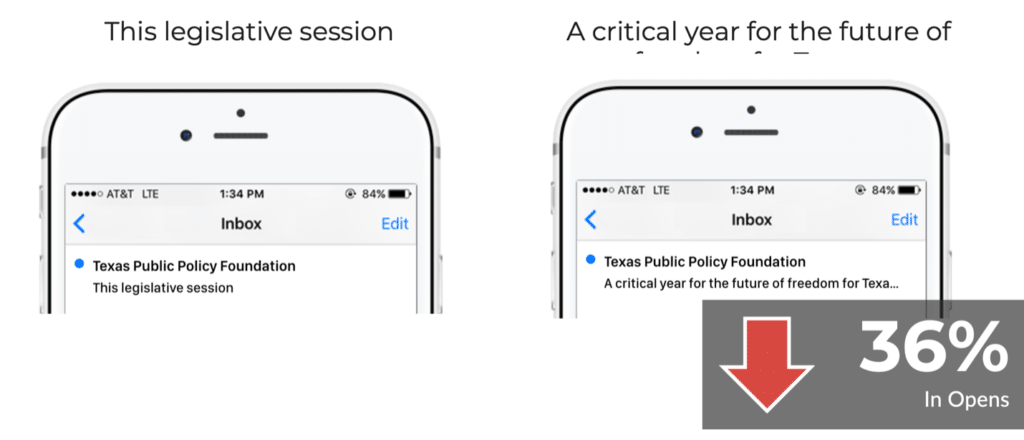
3. Don’t customize your preview text
Your preview text is the first glimpse a donor gets at the actual content of your email.
Many marketers and fundraisers customize this text to make it sound the most appealing. They often include the core details or summary of the email in this limited preview window.
Customizing your preview text, however, tells donors that your email is not intended to be a personal communication. Instead, custom preview text tells donors that you are marketing to them. And people don’t want to be marketed to – they want to be communicated with in a personal way.
Let your preview text show the first line or two of your actual email. This will appear in their inbox just like any other email from a friend, family member, or colleague.
An Email Preview Text Experiment
In this preview text experiment, we wondered if customizing the preview text to showcase the core content of the email would lead to more opens. But the opposite happened.
Customizing the preview text led to a 9% decrease in opens.
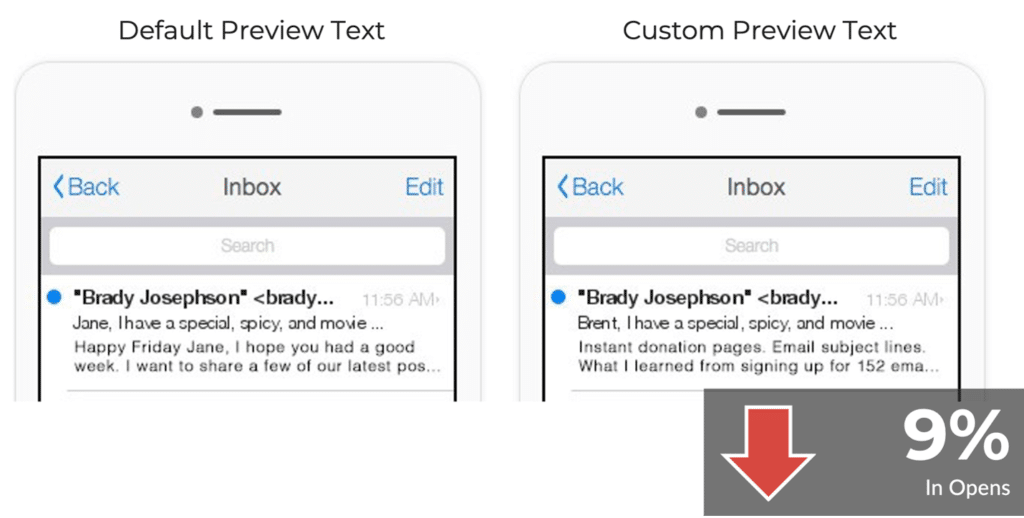
4. Say hello and call your donor by name
Begin your email copy by saying hello and calling your donor by name. This might sound overly simplistic, but the implications are profound.
If people give to people, then you’ll want to start your email off like a conversation. You might use a warm greeting or conversational language such as:
- Hope you’re doing well.
- I wanted to share something with you this morning.
- Something came up that I thought you should know about.
This can lower your donor’s defenses and will set a personal tone for the rest of your year-end fundraising email.
A Fundraising Email Salutation Experiment
In this email salutation experiment, this organization wondered what impact it would have if they called simply said “Hi” and called their donor by their name to start the email.
This simple tactic led to a 270% increase in people clicking through to the landing page.
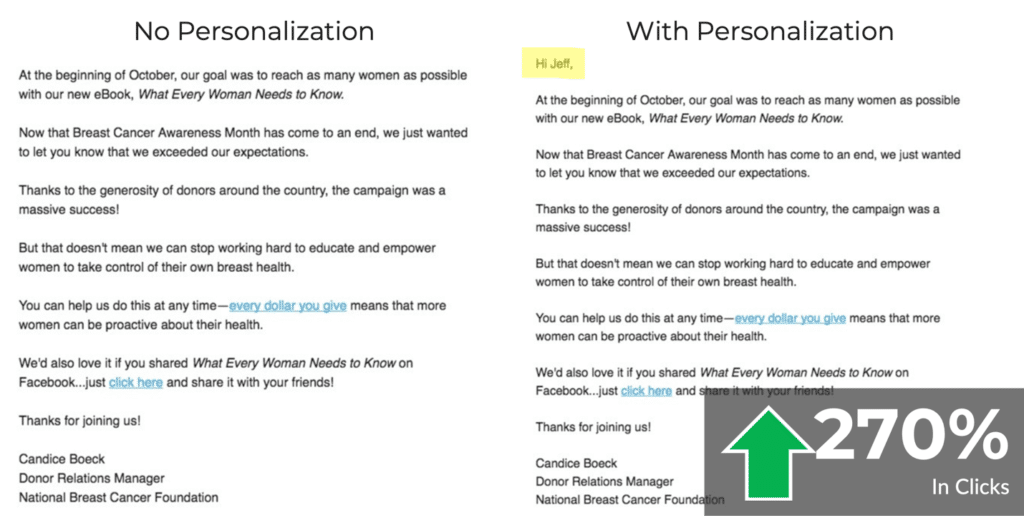
5. Explain the problem at hand
After your greeting, you’ll want to clearly lay out the reason for sending your email. The primary way to do so is to explain the problem at hand.
Generally speaking, this is the core reason your organization exists. It’s the reason you’re asking for funds in the first place. It’s the overarching reason why donors give to you, and why your email subscribers follow you.
Here’s a powerful example from Oxfam where they lay out a very clear and thought-provoking problem:
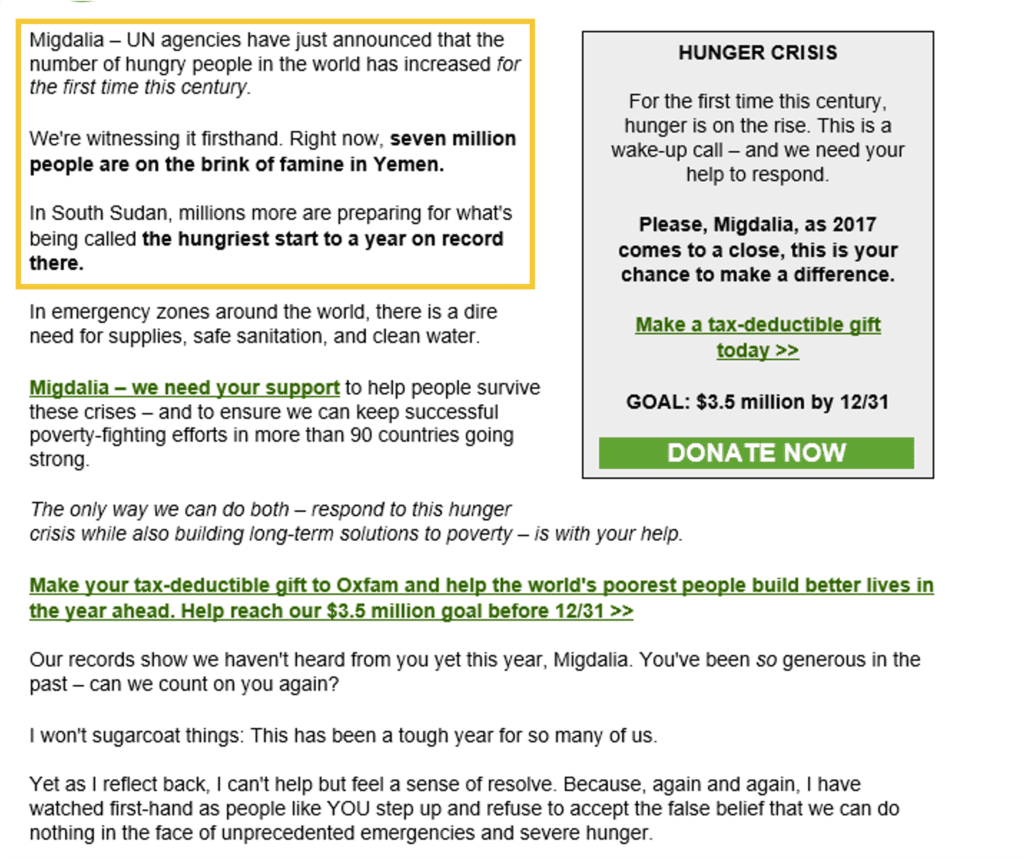
If there is no problem to solve, there is no reason to give.
Spend as much time as you need help donors understand the problem at hand. You might need 2-3 paragraphs to do this well.
6. Propose a solution
Now that you’ve articulated the problem, what is the solution? Use the next section of your email to cast the vision for a solution.
If you have a very far-reaching or broad cause, you may have a very bold and big solution. It’s possible you’ll need significant copy to explain your solution and how it will make a difference.
If your cause is simpler in nature, you might need just a sentence or two to explain what can be done to solve the problem at hand.
A Fundraising Email Messaging Experiment
In this email messaging experiment, this organization wondered if taking more of a direct approach to their fundraising email appeal would lead to greater giving. They present a clear problem & solution. And they position the donor’s voice as the clear solution.
The result? The direct appeal outperformed the soft-donation ask and increased donations by 246%.
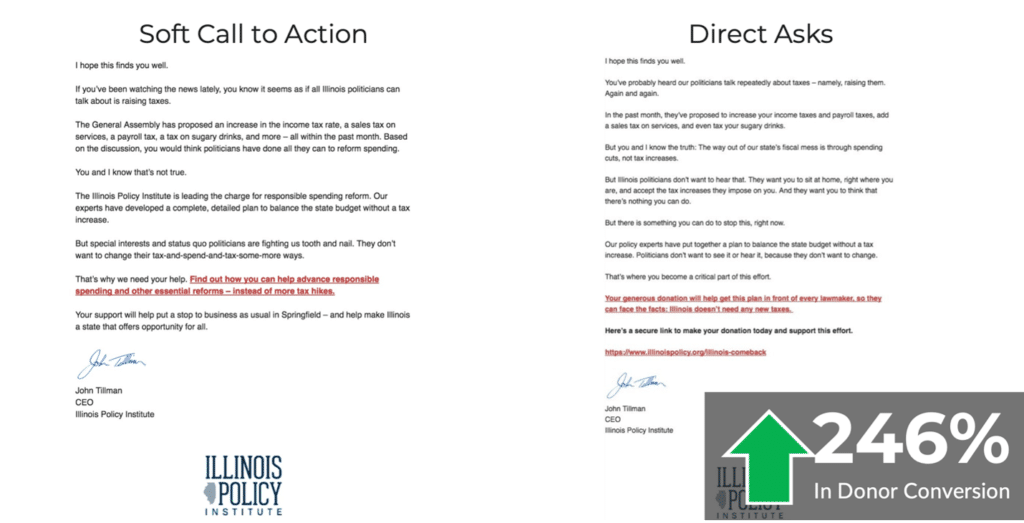
7. Articulate the donor’s impact
This section is one of the most critical. To see significant donations and conversions from your year-end fundraising email, your donor needs to understand how they can make a meaningful impact.
How does a $100 donor impact the problem and solution when your year-end goal is $1 Million?
Use plenty of copy to help answer key questions your donors may have:
- Who will my donation impact?
- What will it do for them?
- What kinds of programs or services does my gift fund?
- How quickly will my donation be put to use?
You may consider using “gift handles” to explain what certain dollar amounts will accomplish. For example: $50 feeds a family for a month; $100 feeds a family for 2 months; $600 feeds a family for half a year; etc.
An Experiment on Illustrating Impact
In this experiment on how to illustrate the impact of a donation, this organization tested using a story-driven approach. Instead of simply stating the need and a call-to-action, they used a series of stories to illustrate the impact a donation would make.
The result? This story-driven approach led to a 52% increase in donations.
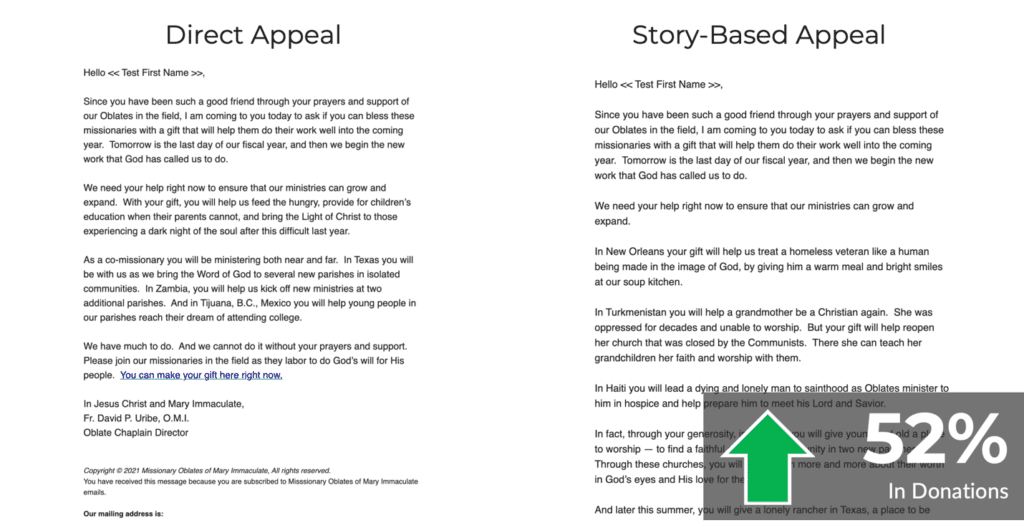
8. Add an incentive to give now
At this point, you should have thoroughly answered the core question: “Why should I give to you, rather than some other organization, or at all?”
As you transition to your call-to-action, consider adding an incentive. An incentive is something that gives donors a reason to give now instead of later.
Some examples of incentives you may consider are:
- A matching opportunity (i.e. give today and a generous donor will match your gift)
- A free gift when you donate today
- A threshold-driven premium (Get a free gift when you give $50 or more today)
- A clear and urgent deadline and goal
A Note on Tax-Deduction as an Incentive
While the tax-deadline at year-end is certainly a factor in the heightened motivation of donors, it’s not a very strong additional incentive to give. Every 501c3 organization can claim that “your gift is tax-deductible.” And if everyone can claim the same incentive, then it’s not very exclusive or appealing.
Try to find a unique and exclusive incentive beyond the tax-deductibility of a donation.
An Experiment on Donation Incentives
In this experiment on donation incentives, this organization wondered if additional clarity about a matching incentive would lead to an increase in donations.
This experiment takes place on a donation page, but illustrates the impact a
match can have on the likelihood of someone giving.
By making the matching incentive abundantly clear, they saw a 24% increase in donations.
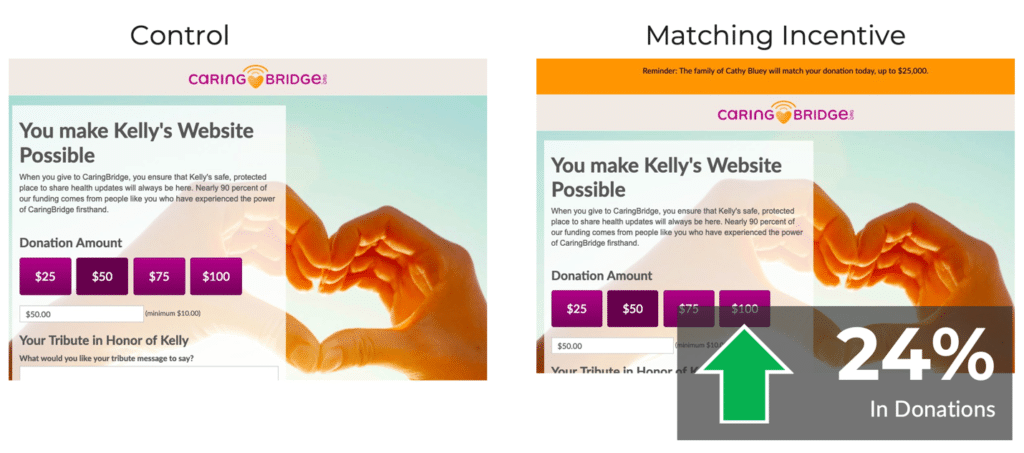
9. Provide a clear call-to-action
Finally, you need to clearly ask your donors to give.
You’ve likely seen and received many year-end fundraising emails that ask you to:
- “Stand with us”
- “Stand up for your principles”
- “Give the gift of hope”
These types of calls-to-action are not clear. What does it mean to “stand”?” Do you want me to volunteer? Should I call someone? Do you want me to vote differently?
And asking someone to “give hope” is something most any organization could ask of their donors.
Instead of using a vague call-to-action, be abundantly clear about the next step. You’re not asking donors to “end world hunger”, you’re asking them to give.
Your call-to-action should say something like:
“Would you consider supporting [insert impact here] with your donation today? You can make your donation here: [insert donation page URL].”
A Donation Call-to-Action Experiment
In this call-to-action experiment, you can see how important clarity of your call-to-action is. In this case, the call-to-action was in the website navigation. Version A said “Donate”, but they wondered if the more personal phrase “You Can Help” would lead to greater donations.
The result? The lack of clarity in the call-to-action decreased donations by 59%. So make sure your calls-to-action are clear.

Need help crafting the perfect year-end appeal? Partner with Marlin and we’ll help put these strategies into action. From copywriting to direct mail to building online campaign landing pages, donation pages to email marketing and advertising, we work with your communications and fundraising teams to deliver a consistent message across multiple channels. Get in touch today – we’d love to chat.


